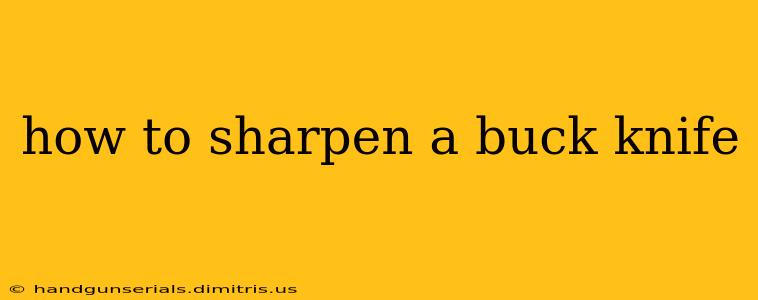Buck knives are renowned for their durability and quality, but even the toughest blades need regular sharpening to maintain their cutting edge. A dull knife is not only inefficient but also dangerous, increasing the risk of accidents. This comprehensive guide will walk you through different methods for sharpening your Buck knife, ensuring you can keep your blade razor-sharp for years to come.
Choosing the Right Sharpening Method
Before you begin, it's crucial to select the appropriate sharpening method for your Buck knife. The best method depends on your skill level, the condition of your blade, and the desired level of sharpness. Here are the most common options:
1. Using a Sharpening Steel: For Routine Maintenance
A sharpening steel is ideal for routine maintenance and touching up your knife's edge between more substantial sharpening sessions. This method is quick and easy, helping to straighten out minor imperfections and maintain the blade's sharpness. It's the best option for those who frequently use their knife. Remember to use a smooth, consistent motion.
2. Using a Sharpening Stone: For More Precise Sharpening
Sharpening stones offer more control and precision than a sharpening steel. They come in various grits, with coarser grits (lower numbers like 100-300) removing more material and finer grits (higher numbers like 6000-8000) polishing the edge to a razor sharpness. You'll need to learn the proper technique, including maintaining the correct angle, but the results are well worth the effort. This method is suitable for more significant sharpening needs.
3. Using an Electric Sharpener: For Convenience and Speed
Electric sharpeners provide a fast and convenient way to sharpen your Buck knife, particularly for those less experienced with manual sharpening. However, some electric sharpeners can remove too much material if used incorrectly, potentially damaging the blade. Choose a high-quality electric sharpener specifically designed for knives and always follow the manufacturer's instructions.
Step-by-Step Guide to Sharpening with a Sharpening Stone (Recommended)
This method provides the most control and yields the best results for maintaining your Buck knife's edge.
Materials You'll Need:
- A sharpening stone (coarse and fine grit)
- Water or oil (depending on your stone type)
- A honing guide (optional, but highly recommended for beginners)
Steps:
- Prepare your stone: Wet or oil your sharpening stone according to the manufacturer's instructions.
- Determine the blade angle: Most Buck knives have a bevel angle of around 20 degrees. If unsure, check your knife's manual or find the specifications online. Maintaining this angle throughout the sharpening process is crucial. A honing guide can significantly help with this.
- Sharpen with the coarse stone: Hold the knife at the correct angle and draw the blade across the stone in a smooth, controlled motion. Repeat this process on both sides of the blade, maintaining consistent pressure and angle.
- Switch to the fine stone: Once you've achieved a reasonably sharp edge with the coarse stone, repeat the process using the fine stone. This step will refine the edge and create a sharper, smoother finish.
- Test the sharpness: Test the sharpness of your blade by gently trying to slice a piece of paper. If it cuts cleanly, you're done. If not, continue sharpening on the fine stone.
- Clean and store: Clean your knife and sharpening stone after each use and store your knife properly to prevent rust and damage.
Maintaining Your Buck Knife's Edge
Regular sharpening is key to keeping your Buck knife sharp. Even with proper sharpening, minor wear and tear are inevitable. Consistent use of a honing steel between major sharpenings will significantly prolong the sharpness of your blade. Avoid using your Buck knife for tasks that exceed its capabilities, as this can damage the blade and shorten its lifespan.
Conclusion
Sharpening your Buck knife may seem daunting initially, but with practice and the right techniques, you'll be able to maintain your knife's cutting edge for years to come. Choose the method that best suits your needs and skill level, and always prioritize safety. A sharp knife is a safe knife – and a well-maintained Buck knife is an investment that will last a lifetime.

